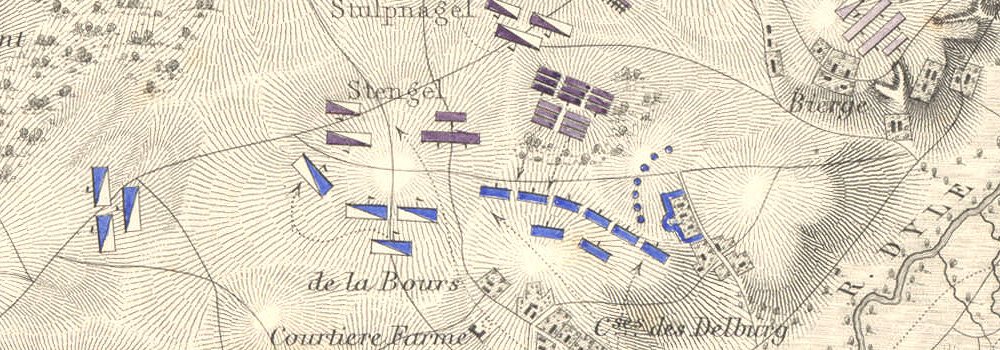wiki :
Background
At the start of 1800, the armies of France and Austria glared at each other across the Rhine. Feldzeugmeister Pál Kray commanded about 120,000 troops. Aside from regular Austrian soldiers, he led 12,000 troops from the Electorate of Bavaria, 6,000 men from the Duchy of Württemberg, 5,000 militia from the Archbishopric of Mainz, and 7,000 militia from the County of Tyrol. Of these, 25,000 men were positioned east of Lake Constance (Bodensee) to defend the Vorarlberg. Kray's remaining 95,000 soldiers lay in the L-shaped angle where the Rhine changes direction from a westerly flow along the northern border of Switzerland to a northerly flow along the eastern border of France. Unwisely, Kray set up his main supply base at Stockach, only a long day's march from French-held Switzerland.
General of Division Jean Victor Marie Moreau led a well-equipped army of 137,000 French soldiers. Of these, 108,000 men were available for field operations while the remaining 29,000 watched the borders of Switzerland and guarded the Rhine fortresses. First Consul Napoleon Bonaparte suggested a plan of operations based on outflanking the Austrians by a thrust from Switzerland, but Moreau would have none of it. Instead Moreau planned to cross the Rhine near Basel where the river turned to the north. Meanwhile, a French column would distract Kray by advancing across the Rhine from the west. Bonaparte also wanted Moreau to detach a corps under Claude Lecourbe to Italy, but Moreau had other plans for this body of troops.
Forces
At the beginning of March, Bonaparte ordered Moreau to form his army into several all-arms army corps. By 20 March 1800, Moreau organized four corps, with the last one serving as an army reserve.[2] The Right Wing was led by Lecourbe and included four divisions. These units were General of Division Dominique Vandamme's 9,632 infantry and 540 cavalry, General of Division Joseph Hélie Désiré Perruquet de Montrichard's 6,998 infantry, General of Division Jean Thomas Guillaume Lorge's 8,238 infantry and 464 cavalry, and General of Division Étienne Marie Antoine Champion de Nansouty's 1,500 grenadiers and 1,280 cavalry.[3]
The Center was led by General of Division Laurent Gouvion Saint-Cyr and comprised four divisions. These were General of Division Michel Ney's 7,270 infantry and 569 cavalry, General of Division Louis Baraguey d'Hilliers' 8,340 infantry and 542 cavalry, General of Division Jean Victor Tharreau's 8,326 infantry and 611 cavalry, and General of Brigade Nicolas Ernault de Rignac Des Bruslys' 2,474 light infantry and 1,616 cavalry.[4]
The Left Wing was commanded by General of Division Gilles Joseph Martin Brunteau Saint-Suzanne and included four divisions. These units were General of Division Claude Sylvestre Colaud's 2,740 infantry and 981 cavalry, General of Division Joseph Souham's 4,687 infantry and 1,394 cavalry, General of Division Claude Juste Alexandre Legrand's 5,286 infantry and 1,094 cavalry, and General of Division Henri François Delaborde's 2,573 infantry and 286 cavalry.[4]
Moreau personally directed the Reserve which was made up of three infantry and one cavalry divisions. These were General of Division Antoine Guillaume Delmas de la Coste's 8,635 infantry and 1,031 cavalry, General of Division Antoine Richepanse's 6,848 infantry and 1,187 cavalry, General of Division Charles Leclerc's 6,035 infantry and 963 cavalry, and General of Division Jean-Joseph Ange d'Hautpoul's 1,504 heavy cavalry.[4]
There were additional troops under Moreau's overall leadership. These included General of Division Louis-Antoine-Choin de Montchoisy's 7,715 infantry and 519 cavalry, detached to hold Switzerland. Fortresses in Alsace and along the Rhine were defended by forces under Generals of Division François Xavier Jacob Freytag, 2,935 infantry; Joseph Gilot, 750 cavalry; Alexandre Paul Guerin de Joyeuse de Chateauneuf-Randon, 3,430 infantry and 485 cavalry; Antoine Laroche Dubouscat, 3,001 infantry and 91 cavalry; and Jean François Leval, 5,640 infantry and 426 cavalry.
Commanders and leaders
France : Laurent Saint-Cyr Holy Roman Empire : Pál Kray
Strength
fr : 25,000 allemands : 20,000
Casualties and losses
2,000 vs 4,000
en français :
http://aufildesmotsetdelhistoire.unblog.fr/2012/05/14/le-9-mai-1800/
